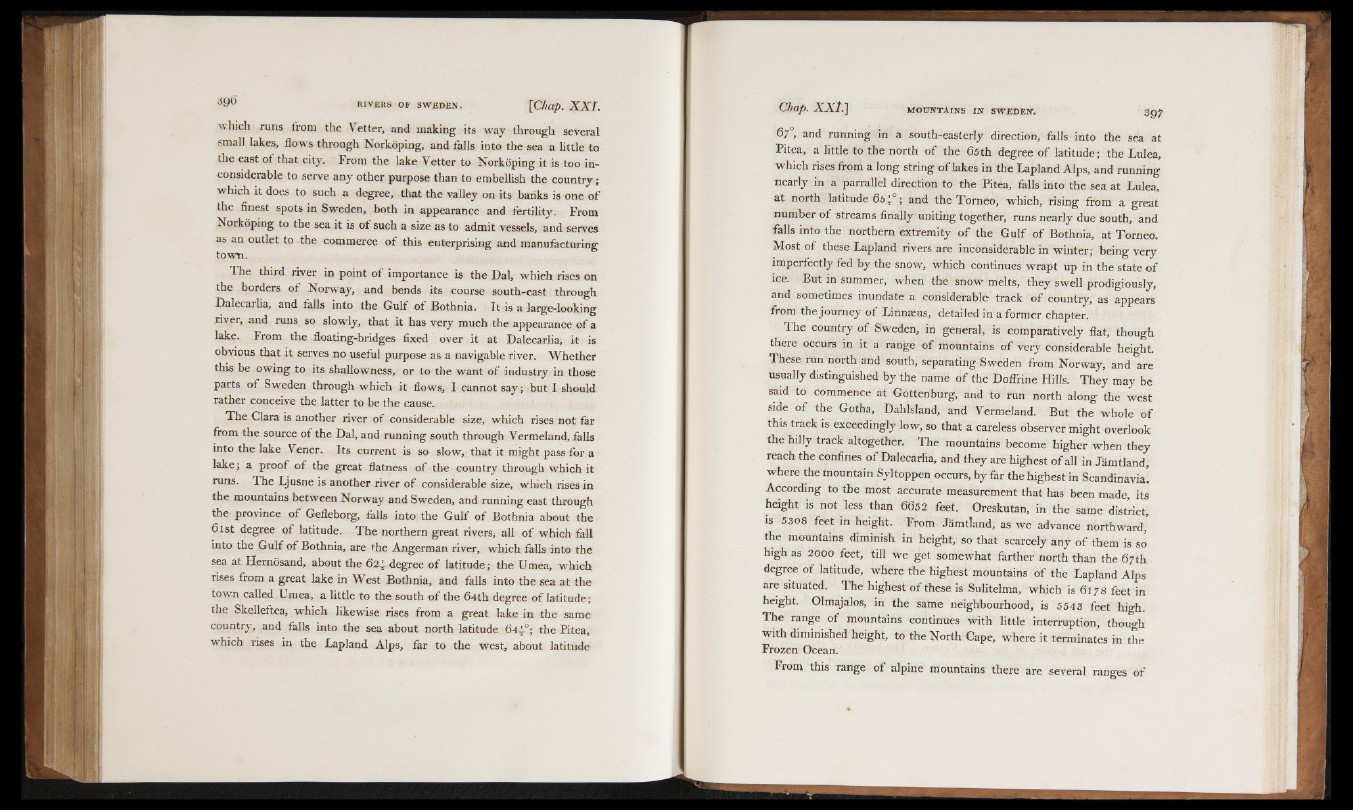
which runs from the Vetter, and making its way through several
small lakes, flows through Norkoping, and falls into the sea a little to
the east o f that city. From the lake Vetter to Norkoping it is too inconsiderable
to serve any other purpose than to embellish the country;
which it does to such a degree, that the valley on its banks is one of
the finest spots in Sweden, both in appearance and fertility. From
Norkoping to the sea it is of such a size as to admit vessels, and serves
as an outlet to the commerce o f this enterprising and manufacturing
town.
The third river in point o f importance is the Dal, which rises on
the borders o f Norway, and bends its course south-east through
Dalecarlia, and falls into the Gulf o f -Bothnia. It is a large-looking
river, and runs so slowly, that it has very much the appearance o f a
lake. From the floating-bridges fixed over it at Dalecarlia, it is
obvious that it serves no useful purpose as a navigable river. Whether
this be owing to its shallowness, or to the want of industry in those
parts o f Sweden through which it flows, I cannot say; but I should
rather conceive the latter to be the cause.
The Clara is another river of considerable size, which rises not far
from the source of the Dal, and running south through Vermeland, falls
into the lake Vener. Its current is so slow, that it might pass for a
lake; a proof of the great flatness o f the country through which it
runs. The Ljusne is another river o f considerable size, which rises in
the mountains between Norway and Sweden, and running east through
the province o f Gefleborg, falls into, the Gulf o f Bothnia about the
6 ls t degree o f latitude. The northern great rivers, all o f which fall
into the Gulf o f Bothnia, are the Angerman river, which falls into the
sea at Hemosand, about the 624 degree of latitude; the Umea, which
rises from a great lake in West Bothnia, and falls into the sea at the
town called Umea, a little to the south of the 64th degree of latitude;
the Skelleftea, which likewise rises from a great lake in the same
country, and falls into the sea about north latitude 644°; the Pitea,
which rises in the Lapland Alps, far to the west, about latitude
67° and running in a south-easterly direction, falls into the sea at
Pitea, a little to the north o f the 65th degree o f latitude; the Lulea,
which rises from a long string o f lakes in the Lapland Alps, and running
nearly in a parrallel direction to the Pitea, falls into the sea at Lulea,
at north latitude 654.°; and the Torneo, which, rising from a great
number o f streams finally uniting together, runs nearly due south, and
falls into the northern extremity o f the Gulf o f Bothnia, at Torneo.
Most o f these Lapland rivers are inconsiderable in winter; being very
imperfectly fed by the snow, which continues wrapt up in the state o f
ice. But in summer, when the snow melts, they swell prodigiously,
and sometimes inundate a Considerable track o f country, as appears
from the journey of Linnaeus, detailed in a former chapter.
The country o f Sweden, in general, is comparatively flat, though
there occurs in it a range of mountains of very considerable height.
These run north and south, separating Sweden from Norway, and are
usually distinguished by the name of the Doffrine Hills. They may be
said to commence at Gottenburg, and to run north along the west
side of the Gotha, Dahlsland, and Vermeland. But the whole o f
this track is exceedingly low, so that a careless observer might overlook
the hilly track altogether. The mountains become higher when they
reach the confines o f Dalecarlia, and they are highest o f all in Jamtland,
where the mountain Syltoppen occurs, by far the highest in Scandinavia.
According to the most accurate measurement that has been made, its
height is not less than 6652 feet. Oreskutan, in the same district,
is 5308 feet in height. From Jamtland, as we advance northward,
the mountains diminish in height, so that scarcely any o f them is so
high as 2000 feet, till we get somewhat farther north than the 67th
degree o f latitude, where the highest mountains o f the Lapland Alps
are situated. The highest o f these is Sulitelma, which is 6178 feet in
height. Olmajalos, in the same neighbourhood, is 5543 feet high.
The range o f mountains continues with little interruption, though
with diminished height, to the North Gape, where it terminates in the
Frozen Ocean.
From this range o f alpine mountains there are several ranges o f